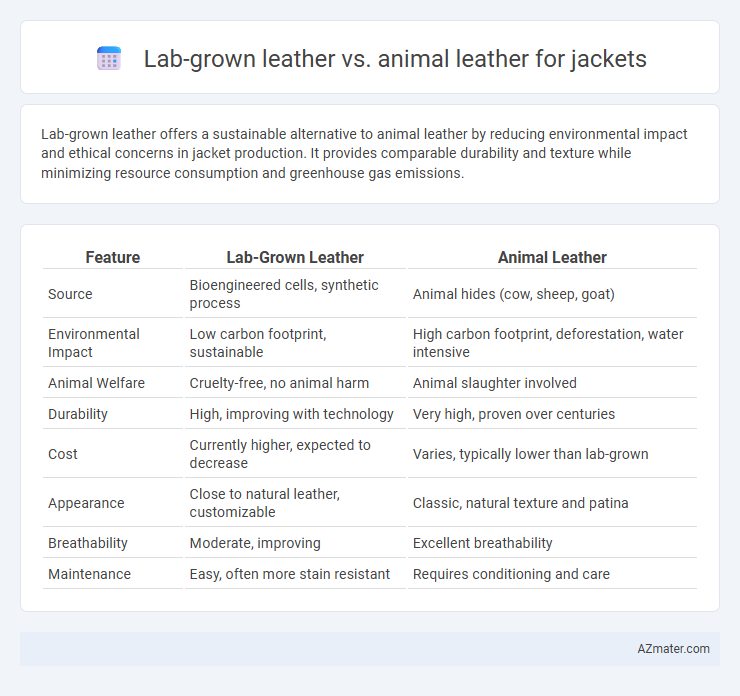Lab-grown leather offers a sustainable alternative to animal leather by reducing environmental impact and ethical concerns in jacket production. It provides comparable durability and texture while minimizing resource consumption and greenhouse gas emissions.
Table of Comparison
| Feature | Lab-Grown Leather | Animal Leather |
|---|---|---|
| Source | Bioengineered cells, synthetic process | Animal hides (cow, sheep, goat) |
| Environmental Impact | Low carbon footprint, sustainable | High carbon footprint, deforestation, water intensive |
| Animal Welfare | Cruelty-free, no animal harm | Animal slaughter involved |
| Durability | High, improving with technology | Very high, proven over centuries |
| Cost | Currently higher, expected to decrease | Varies, typically lower than lab-grown |
| Appearance | Close to natural leather, customizable | Classic, natural texture and patina |
| Breathability | Moderate, improving | Excellent breathability |
| Maintenance | Easy, often more stain resistant | Requires conditioning and care |
Introduction to Lab-Grown Leather and Animal Leather
Lab-grown leather, made from cultured animal cells, offers a sustainable alternative to traditional animal leather by reducing the environmental impact and ethical concerns associated with livestock farming. Animal leather, derived from the hides of cows, pigs, or other animals, is valued for its durability, natural texture, and classic aesthetic but involves resource-intensive processes and animal welfare issues. Advances in biotechnology enable lab-grown leather to mimic the look and feel of animal leather while minimizing carbon footprint and water usage.
Manufacturing Process: Lab-Grown vs Animal Leather
Lab-grown leather is manufactured using bioengineering techniques that cultivate collagen fibers from animal cells in controlled environments, significantly reducing water usage and greenhouse gas emissions compared to traditional leather. Animal leather production involves raising livestock, which requires extensive land, water, and feed resources, followed by chemical-intensive tanning processes that contribute to environmental pollution. The lab-grown leather manufacturing process offers a more sustainable, consistent quality material with lower ecological impact, while animal leather remains reliant on resource-intensive agricultural practices and toxin-heavy treatments.
Environmental Impact Comparison
Lab-grown leather significantly reduces environmental impact by minimizing greenhouse gas emissions, water usage, and land consumption compared to traditional animal leather production, which relies on livestock farming responsible for high carbon footprints and deforestation. The production of animal leather also involves toxic chemicals in tanning processes that contribute to water pollution, whereas lab-grown leather uses less harmful substances and generates less waste. Consumer adoption of lab-grown leather jackets supports sustainable fashion by lowering ecological damage and promoting resource efficiency.
Durability and Longevity of Each Material
Lab-grown leather exhibits high durability with resistance to cracking and wear, maintaining its structural integrity for several years under regular use. Animal leather, known for its natural toughness and ability to develop a unique patina over time, often surpasses lab-grown leather in longevity when properly cared for. While lab-grown alternatives continue to improve, traditional animal leather jackets typically offer a longer lifespan and superior aging characteristics.
Ethical Considerations and Animal Welfare
Lab-grown leather offers a sustainable alternative to traditional animal leather by eliminating the need for animal farming and slaughter, significantly reducing animal suffering. Ethical considerations highlight the reduction of environmental impact and animal cruelty associated with livestock production. Choosing lab-grown leather for jackets supports animal welfare by promoting cruelty-free materials without compromising durability or aesthetics.
Cost Analysis: Lab-Grown vs Animal Leather Jackets
Lab-grown leather jackets often cost 20-30% more than traditional animal leather due to advanced manufacturing processes and limited production scale. Animal leather jackets benefit from established supply chains and economies of scale, resulting in lower prices and greater market availability. Long-term, as lab-grown leather technology advances, production costs are expected to decrease, potentially making it a more competitive and sustainable choice in the jacket industry.
Aesthetic Differences and Customization Options
Lab-grown leather offers a consistently smooth texture and uniform color, while animal leather features natural variations and unique grain patterns that enhance each jacket's individuality. Customization options for lab-grown leather are extensive, including precise color matching and tailored finishes, whereas animal leather customization relies more on traditional dyeing and embossing techniques. Both materials allow for diverse jacket styles, but lab-grown leather excels in replicating exotic textures without ethical concerns, appealing to consumers seeking innovative aesthetics.
Comfort, Fit, and Performance in Jackets
Lab-grown leather offers superior breathability and consistent texture, enhancing comfort in jackets compared to traditional animal leather, which can vary in softness and thickness. The precision manufacturing of lab-grown leather allows for tailored fit and flexibility, ensuring jackets conform better to body movements without sacrificing durability. Performance-wise, lab-grown leather provides increased resistance to water and wear, making it a practical choice for jackets exposed to diverse weather conditions while maintaining a sleek appearance.
Market Trends and Consumer Preferences
Lab-grown leather is gaining traction in the jacket market due to growing consumer demand for sustainable and cruelty-free alternatives, driven by increased environmental awareness and ethical considerations. Market trends indicate a rising preference for innovative materials offering similar durability and aesthetics as traditional animal leather, but with a lower carbon footprint and reduced resource usage. Leading fashion brands are incorporating lab-grown leather into their collections, reflecting a shift towards eco-conscious purchasing behavior among millennials and Gen Z consumers.
Future Prospects for Leather Alternatives in Fashion
Lab-grown leather presents a sustainable and cruelty-free alternative to traditional animal leather, with rapid advancements in biotechnology enabling scalable production and improved material properties. The fashion industry is increasingly adopting lab-grown leather due to consumer demand for ethical and eco-friendly products, alongside regulatory pressures to reduce environmental impact. Innovations in lab-grown leather manufacturing suggest a transformative shift in jacket design and production, promising reduced carbon footprints and enhanced customization options for future fashion markets.

Infographic: Lab-grown leather vs Animal leather for Jacket
 azmater.com
azmater.com